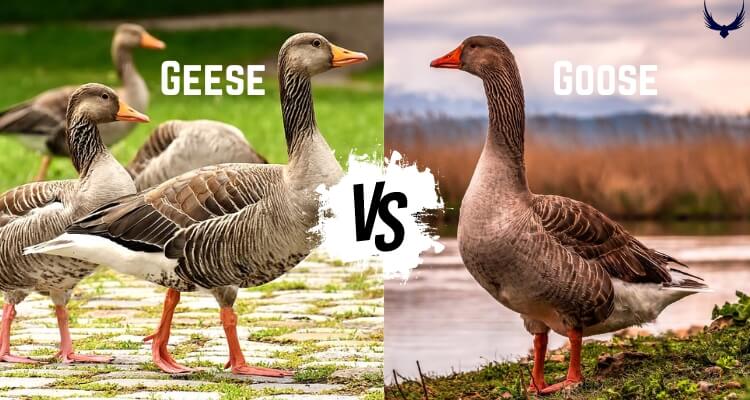In the debate between goose and geese, it’s not just about singular and plural. These birds have unique traits that make them interesting to compare. What makes a single goose different from a group of geese?
Let’s explore the mystery of Goose vs Geese and discover what makes them special in the world of wildlife.
What’s the Difference Between Goose and Geese?
Geese and goose are two terms for the same waterfowl. They belong to a family called Anatidae. Geese are social, loud, and messy birds. They are good at swimming and floating on water.
Like ducks and swans, geese migrate all year. They make their homes near lakes and rivers using twigs, grasses, feathers, and mud.
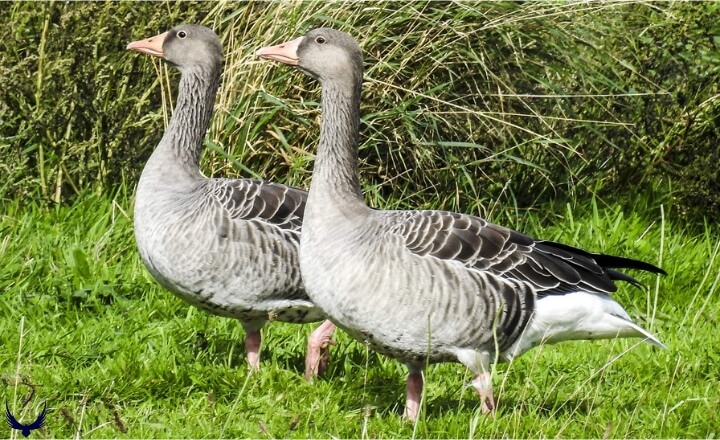
They share some similarities, but there is difference between goose and geese.
Goose Vs Geese: Differences
Singular vs. Plural: “Goose” is the singular term used to refer to an individual bird, while “geese” is the plural form used to refer to multiple birds of the same species.
Gender: The term “goose” typically refers to a female bird, while the male counterpart is called a “gander.”
Goose Vs Geese: Similarities
Waterfowl Family: Both goose and geese are the same and belong to the Anatidae family, which includes ducks, swans, and other waterfowl species.
Habitat: Most goose and geese species are found in wetland areas, such as lakes, ponds, rivers, and marshes, where they have access to water and suitable nesting sites.
Diet: Goose and geese are primarily herbivorous birds that feed on aquatic vegetation, grasses, grains, and seeds. But on some occasions, they eat insects and fish, making them omnivores.
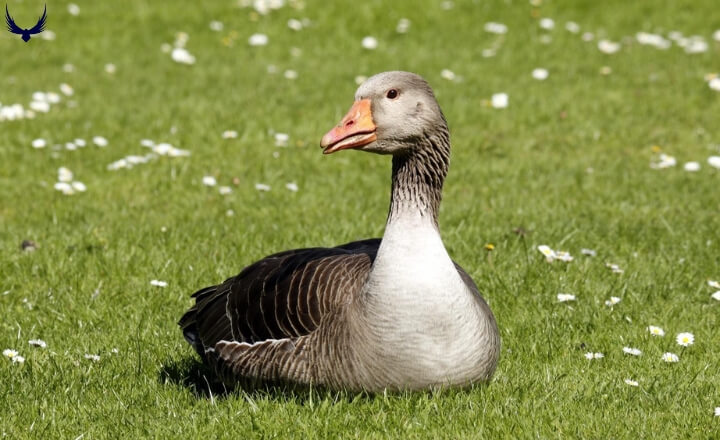
Social Behavior: Goose and geese are known for their strong social bonds and often form monogamous pair bonds. They exhibit parental care, with both parents participating in the incubation and rearing of their young.
Goose Vs Geese: Characteristics
Goose
- A single individual bird
- Adapted for swimming and walking on land with webbed feet
- Often forms monogamous pair bonds and exhibits parental care
Geese
- A group or flock of multiple individual goose
- Exhibit strong social bonds and hierarchical structures
- Migratory behavior, with some species undertaking long-distance migrations
- Loud and distinctive honking vocalizations
- Aggressive behavior, especially during breeding and nesting seasons
Goose Vs Geese: Habitat
Geese and goose are found in various wetland habitats, including:
- Freshwater lakes, ponds, and rivers
- Marshes and swamps
- Agricultural fields and grasslands (during migration and breeding seasons)
- Coastal areas and estuaries
Goose Vs Geese: Feeding Habits
Both goose and geese are mainly herbivorous and rely on various plant materials for their diet:
- Grasses, grains, and seeds from agricultural fields
- Aquatic vegetation, such as pondweed, duckweed, and algae
- Occasionally supplemented with insects, mollusks, or small crustaceans making them omnivores
Geese vs Goose: Flying Patterns
Geese are known for their distinctive V-shaped flying formation, with one lead goose at the front.
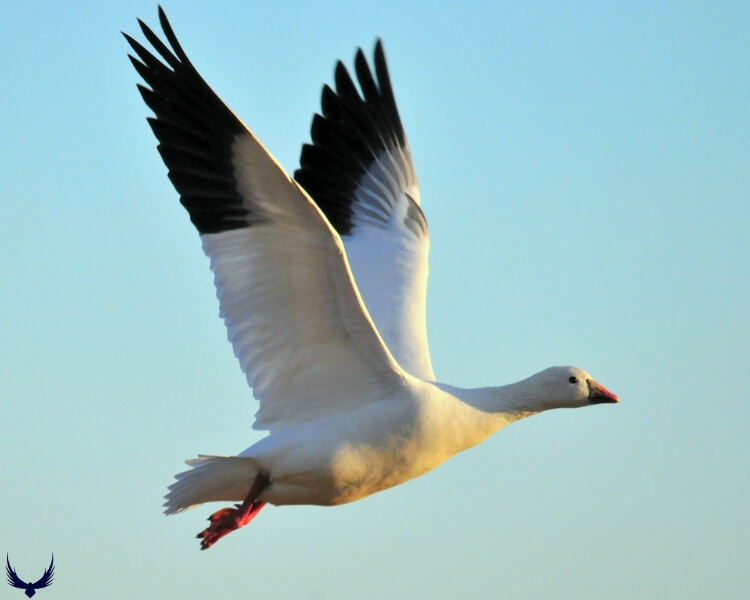
- This V-shaped flying pattern is called a Skein.
- The V-shape is an energy-efficient way for the flock to fly, as each bird benefits from the updraft created by the bird in front of it.
- The lead goose rotates periodically to distribute the effort of breaking the air resistance.
Geese vs Goose: Flying Speeds
The flying speed of geese can vary depending on the species and wind conditions.
- The average cruising speed for most geese during migration is around 40 to 50 mph.
- Some species, like the Snow Goose, can reach speeds of up to 70 mph with favorable tailwinds.
What do Geese Eat?
Geese mainly eat plants like grass, grains, and seeds. They also eat aquatic plants when near water. Sometimes they eat insects and small creatures.
In urban areas, they might eat bread and other human food, but it’s not good for them. Geese spend a lot of time looking for food. They use their bills to eat grass and plants.
What is a Group of Geese Called?
A group of geese on land is called a gaggle. When flying, they are in a skein or wedge formation. In water, they are called plump. The term gaggle is the most common name for a group of geese. It comes from the noisy sounds they make when gathered.
Other names for a group of geese include badling, or team, but gaggle is the most widely used term.
How Long do Geese Live?
Geese in captivity can live 10 to 25 years, and with good care, some can reach 30 years. In the wild, geese live shorter lives, usually 5 to 15 years, due to predators, hunting, habitat loss, and the environment.
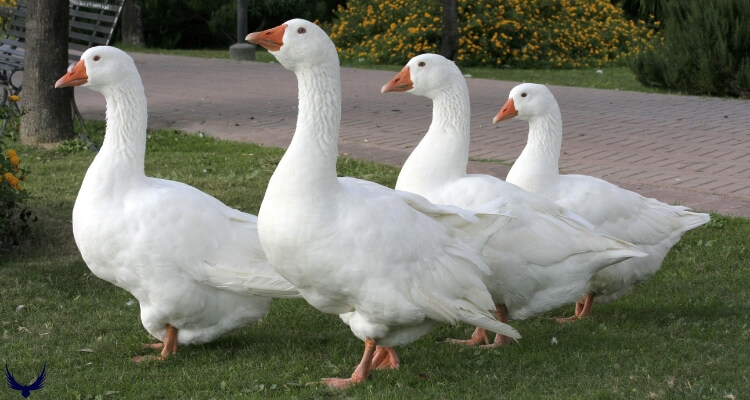
Conclusion
Goose and geese share some similarities as waterfowl species, the primary goose and geese difference lies in the singular and plural forms used to refer to them, as well as their specific roles within a flock or social group.
FAQs – Goose Vs Geese
Why do Geese Fly in a V Formation?
The V-formation allows each bird to take advantage of the updraft created by the bird in front, reducing wind resistance and conserving energy during long migrations.
Can Geese be Kept as Pets?
It is possible to keep geese as pets, they require a significant amount of space, proper housing, and care. They can also be noisy and aggressive, making them challenging to keep as household pets.
What is a Female Goose Called?
A female goose is called a hen. Hens are smaller than ganders. During breeding season, hens lay and sit on the eggs, while ganders protect the nest and family. Hens often lead families of goslings, taking care of and protecting them.
What is a Male Goose Called?
A male goose is called a gander. Ganders are adult male geese and are usually bigger than female geese. They are protective and territorial, especially during breeding season. Ganders make loud honking sounds to mark their territory and warn others to stay away.
What is a Baby Goose Called?
Baby geese are called goslings.
What does a Goose Sound Like?
Geese make different sounds like a loud honk that can be heard far away, grunts when they are happy, and high-pitched sounds to attract a mate. Goslings make peeping sounds to call their parents.
Are Geese More Aggressive than Ducks?
Yes, geese are typically more aggressive, especially during the breeding season when they are protecting their nests and goslings. They can be territorial and may hiss, flap their wings, or even chase people or animals that come too close.
What is the Main Physical Difference Between Geese and Swans?
The most noticeable difference is size. Swans are much larger than geese, with longer necks and a more graceful appearance. Swans also have a distinctive curved neck shape when swimming, while geese have a straighter neck.
How do you Identify if it’s a Goose or Geese?
If you see one bird, it’s a goose. If you see more than one, they are referred to collectively as geese.

